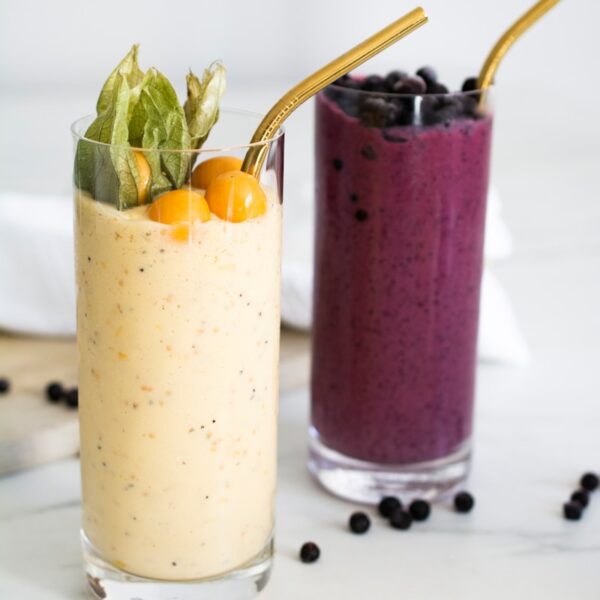How To Make A Smoothie Drink: A Step-by-Step Guide for a Nutritious Start to Your Day
Do you ever wonder how to make a healthy smoothie drink? What liquid do you use? Is milk or yogurt better for smoothies? What is the secret to making a good smoothie that won’t make me feel bloated and gain weight? I’ve got you covered! Smoothies are a versatile, delicious, and nutrient-packed way to fuel your body. Whether you’re looking for a quick breakfast, a post-workout refuel, or a refreshing afternoon snack, smoothies can be tailored to suit your taste and nutritional needs. Let’s dive into the basics of crafting the perfect smoothie, the ultimate fast food!
What are the benefits of drinking smoothies?
- Boost energy
- Helps with weight loss, clearer skin and strong nails
- Helps to reduce sugar cravings
- Packed with antioxidants and phytonutrients to fight illness, aging and the damage from free radicals
- Can improve your mood by helping you to process stress, balance nerves and feel more positive
- They are just, plain, yummy and a very easy way to get more greens into your diet.
Step 1: Choose Your Base
The base sets the tone for your smoothie’s texture and flavor. Here are some popular options:
- Liquid Bases:
- Water: A calorie-free, neutral option and happens to be my favorite choice.
- Nut or seed milk: Adds creaminess with a hint of nuttiness.
- Coconut Water: Light and hydrating, with natural electrolytes.
- Herbal tea: For a different flavor
- Cold decaf coffee: just to switch things up if you need to
Start with about 1 to 1.5 cups of liquid to ensure a smooth blend.
Step 2: Add Fruits and Veggies
Fruits and vegetables provide essential vitamins, minerals, and fiber. Mix and match your favorites for a balanced smoothie:
- Fruits: 1 handful or 1 cup. (frozen are a great option)
- Banana: Add natural sweetness and creaminess.
- Berries (strawberries, blueberries, raspberries): Rich in antioxidants.
- Mango or Pineapple: For a tropical twist.
- Plums: A great source of fiber and subtle sweetness.
- Kiwi: golden ones are delicious in smoothies
- Vegetables: 2 handfuls or 2 cups
- Spinach or Kale: Mild in flavor but high in nutrients. Baby kale or baby spinach blend beautifully and taste great
- Mint or Basil: Refreshing and hydrating.
- Collards, Swiss chard, beet greens or dandelion greens: packed with nutrients
- Cilantro: adds a little kick.
Aim for 1 cup of fruits and 2 cups veggies for a perfect combination
Step 3: Boost with Protein and Healthy Fats
To make your smoothie more filling, add some protein and healthy fats:
- Protein Options: 1 scoop
- Greek Yogurt
- Protein Powder (plant-based or whey). If you are pescatarian or vegetarian, choose a plant-based protein. Whey is a dairy source.
- Hemp, pea protein
- Egg whites
- Healthy Fats:
- Avocado: Adds creaminess without a strong flavor.
- Nut Butter (almond, peanut, or cashew): Adds richness and a nutty taste.
- Seed butter
- Chia seeds
- Coconut Oil
- Flax oil
Add 1-2 tablespoons of these ingredients.
Step 4: Sweeten Naturally (Optional)
If your smoothie needs a touch more sweetness, try these natural options:
- Raw Honey
- Maple Syrup
- Dates
- Stevia
- Banana
Start with 1-2 teaspoons and adjust to taste.
Step 5: Add Ice or Frozen Ingredients
To achieve a cold, refreshing texture, include a handful of ice cubes or use frozen fruits. Frozen bananas, berries, or mangoes work especially well so that you won’t have to add any ice if you don’t want to.
Step 6: Blend It Up!
Combine all your ingredients in a blender. Start on low speed and gradually increase to high, blending until smooth. If the consistency is too thick, add more liquid. If it’s too thin, toss in a few more frozen fruits or ice cubes.
Step 7: Enjoy and Customize
Pour your smoothie into a glass or a portable cup, and enjoy! You can also get creative by topping it with:
- Maca Root Powder
- Coconut Flakes
- Extra Berries
- A sprinkle of chia or flax seeds
- Cinnamon
- Turmeric (not too much, it is very potent)
- Spirulina
- Vitamin C powder
Want to try my favorite smoothie drink?
I have created the perfect blend of ingredients that have a healthy balance of protein, fiber and fat in order to be a meal replacement. If you are eating a source of protein, you can skip the protein powder.
Sample Recipe: Blueberry Banana Power Smoothie
Here’s a simple and refreshing smoothie to get you started:
- 1 cup water
- 1 cup, frozen blueberries
- 1 half piece, medium banana
- 2 cups fresh baby spinach
- 1 scoop, protein powder
- 1 tablespoon creamy, all natural peanut butter
Blend until smooth, and enjoy a tropical escape in every sip!
Nutrition Facts: Total calories 345, Carbs: 37 grams, Fiber: 10 grams, Protein: 20-25 grams, Fat: 8 grams
Servings: 1, 16-24 ounce serving
Smoothies are an easy and delicious way to pack more nutrients into your day. Experiment with different combinations to discover your personal favorites. Do not skip the protein because protein as well as fat are satiating nutrients. Happy blending!



Leave a Comment